Key takeaways:
- Identifying relevant KPIs connected to specific business goals is crucial for effective decision-making and navigating performance.
- Ongoing analysis and feedback from the team help ensure that KPIs remain relevant and engaging, fostering a culture of continuous improvement.
- Utilizing qualitative insights and personal narratives enhances the interpretation of KPIs, making data more relatable and impactful for team members.
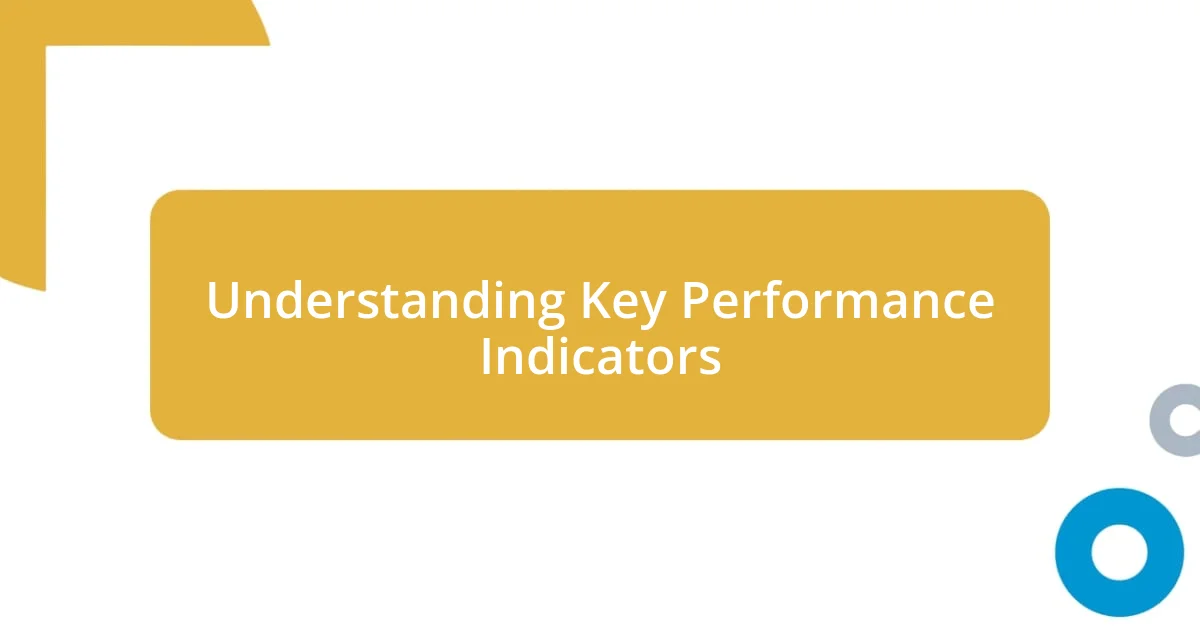
Understanding Key Performance Indicators
Key Performance Indicators, or KPIs, serve as the compass for navigating success in any organization. From my experience, identifying the right KPIs can be a game-changer; it’s like finding that missing puzzle piece that suddenly brings the whole picture into focus. Have you ever felt lost in a sea of data, unsure which metrics truly matter?
When I first started working with KPIs, I struggled to discern which indicators were genuinely reflective of our goals. I remember sitting in countless meetings, overwhelmed by options. It wasn’t until I took a step back and connected our KPIs to tangible business outcomes that I began to see their true value. It’s crucial to ensure each KPI aligns with your strategic objectives—otherwise, they can lead you astray instead of guiding you toward success.
I often encourage others to think of KPIs as a narrative that unfolds over time. Each metric tells part of the story of your organization’s performance. For instance, while sales figures might provide a snapshot of success, customer retention rates reveal how well you’re nurturing those relationships. Isn’t it fascinating how KPIs can transform complex data into compelling narratives that drive informed decisions?
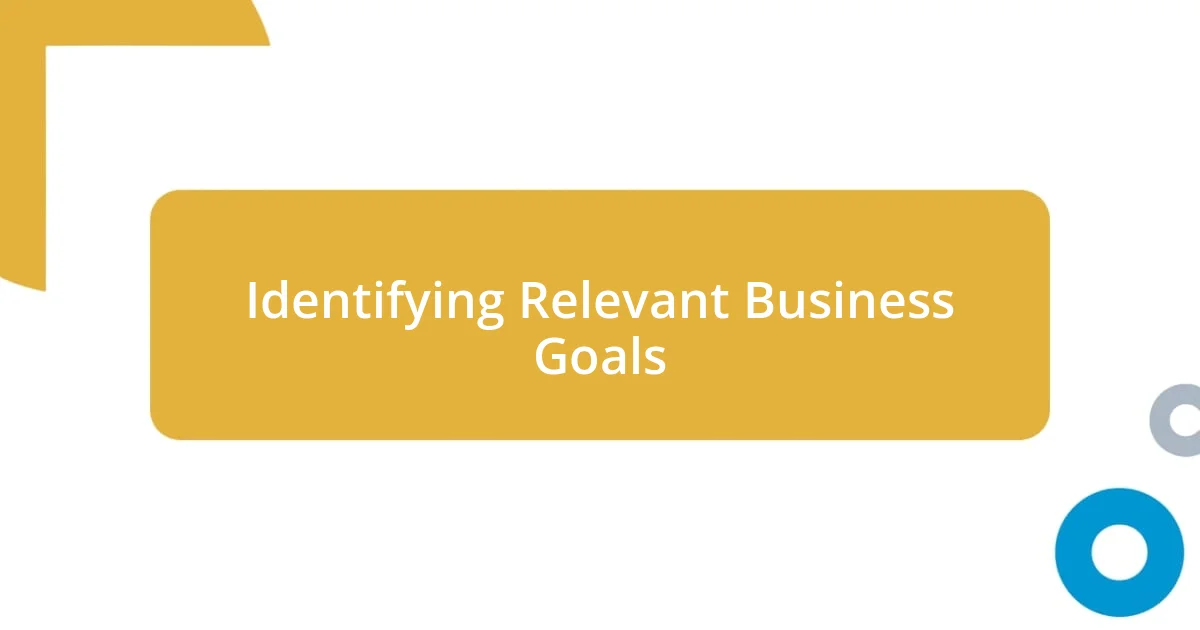
Identifying Relevant Business Goals
Identifying relevant business goals is pivotal in shaping your KPIs. I vividly remember a time when my team and I were tasked with improving our customer engagement metrics. We dove right into analytics, but it felt like we were shooting arrows in the dark. It was only after we paused to clearly define our primary goal—enhancing customer satisfaction—that we could pinpoint the right KPIs to track. Aligning metrics with specific, measurable aspirations transforms an overwhelming task into a focused strategy.
To help clarify how to identify these goals, consider the following points:
- Understand Your Vision: Reflect on the overarching mission of your organization.
- Engage Stakeholders: Get input from team members who will interact with the business goals daily.
- Focus on Impact: Choose goals that will resonate with your target audience and create meaningful change.
- Assess Current Data: Utilize existing metrics to identify gaps and opportunities.
- Be Flexible: Recognize that goals may evolve, and it’s important to re-evaluate periodically.
This process not only streamlines decision-making but also builds a stronger foundation for your KPI framework.
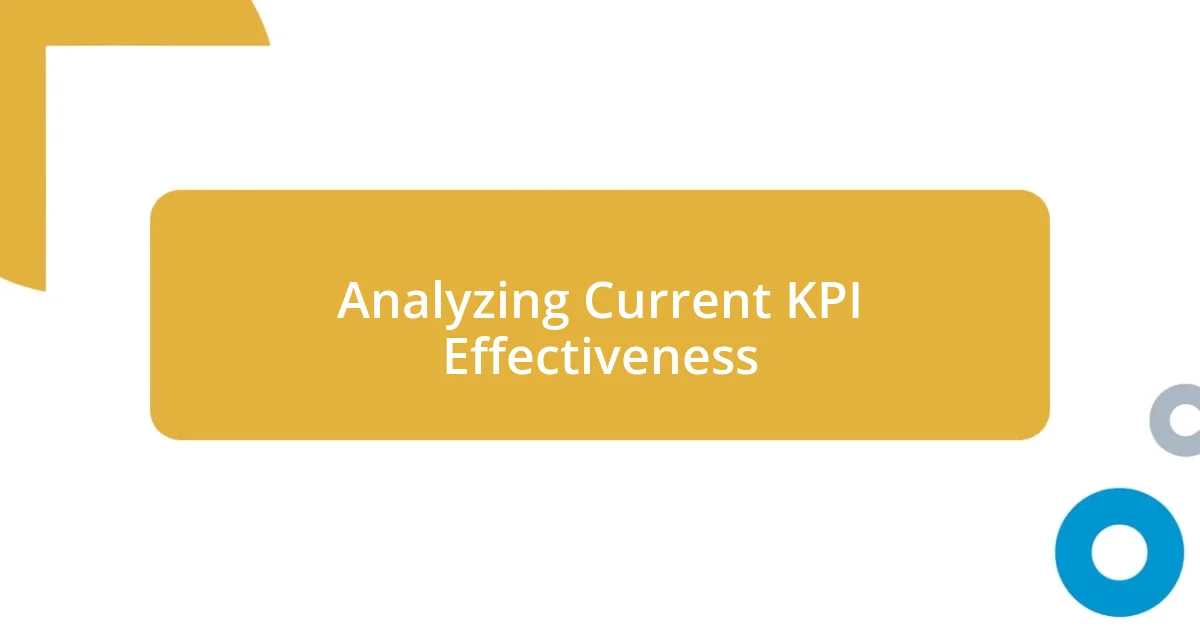
Analyzing Current KPI Effectiveness
Understanding the effectiveness of your current KPIs is essential for driving growth. I recall a time when I reviewed the performance of our indicators, and it was both eye-opening and daunting. Some metrics simply didn’t resonate with our team or reflect our real progress, while others sparked intense discussions about what success actually looked like for us. This process of analysis highlighted the need for constant re-evaluation—KPIs shouldn’t be static but rather dynamic guides that adapt to shifting business landscapes.
When I dug deeper into our KPI performance, it became clear which ones were truly valuable and which ones were just noise. I started by asking my team probing questions: “Are these metrics helping us make informed decisions? Do they align with our strategic goals?” This approach fostered open dialogue and led to mutual understanding. In particular, we found that while sales numbers were impressive, they didn’t capture the entire customer journey, so we began incorporating customer feedback as a key indicator.
Through this examination, I learned that data alone doesn’t convey effectiveness; the context and the story behind it are equally important. For example, while a high churn rate might initially seem alarming, we discovered underlying factors that led us to innovate our services to retain customers. Connecting the dots between KPIs and their real-world implications allowed us to shape a more impactful strategy.
| Current KPI | Effectiveness Analysis |
|---|---|
| Sales Revenue | Shows growth but may overlook customer satisfaction |
| Customer Engagement Rate | Indicates connection but requires context for true impact |
| Net Promoter Score (NPS) | Highlights loyalty but needs regular feedback loops |
| Website Traffic | Reflects interest but should align with conversion metrics |
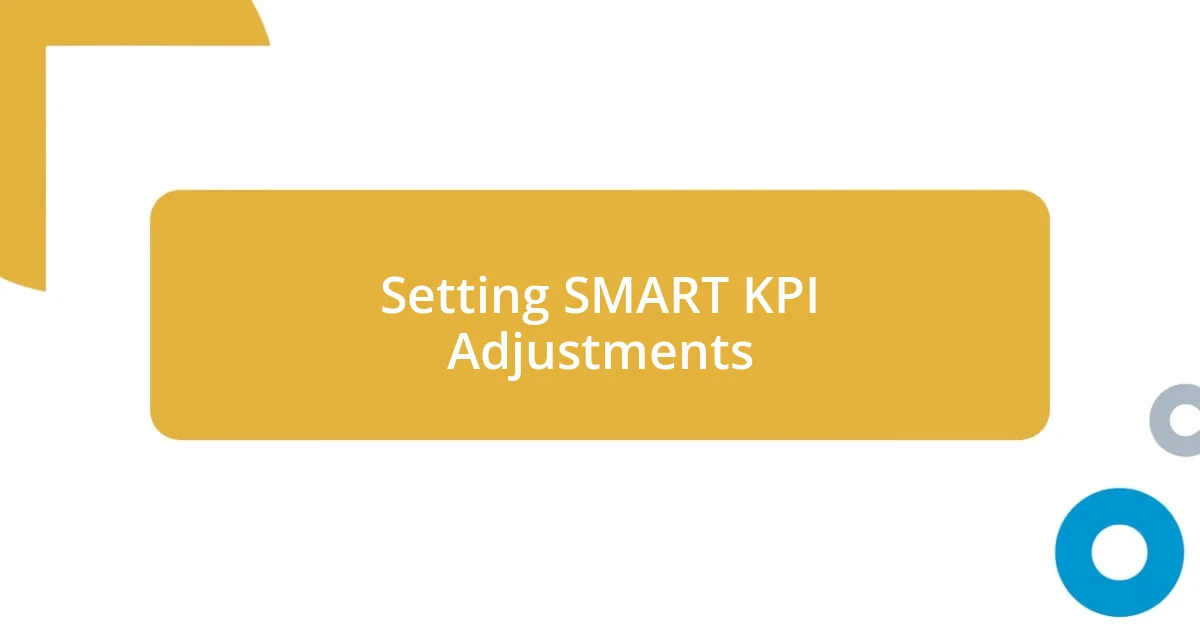
Setting SMART KPI Adjustments
Setting SMART adjustments to your KPIs is a game-changer. I’ve always found that the SMART criteria—Specific, Measurable, Achievable, Relevant, Time-bound—provides a solid framework. For instance, instead of setting a vague goal like “improve engagement,” I shifted to “increase our social media engagement rate by 20% over the next quarter.” That clarity gave my team a tangible target, creating a shared sense of purpose.
When I first adopted this approach, I recall feeling overwhelmed by the multitude of metrics at my disposal. I asked myself, “Which ones actually matter?” I discovered that by focusing on specific KPIs aligned with our strategic priorities, we could drive real change. For example, we implemented weekly check-ins to monitor progress, ensuring everyone remained accountable and motivated. The transformation was remarkable, both in our performance metrics and team morale.
It’s important to continually revisit and refine your KPIs to ensure they remain relevant. I remember a phase when we realized that our initial targets were no longer aligned due to shifts in market conditions. By collaboratively adapting our KPIs to reflect new insights, we stayed agile and responsive. This flexibility empowered us to celebrate small victories along the way, reinforcing our team’s confidence and resilience. It’s amazing how a little adjustment can keep your goals in sync with your ever-evolving business landscape.
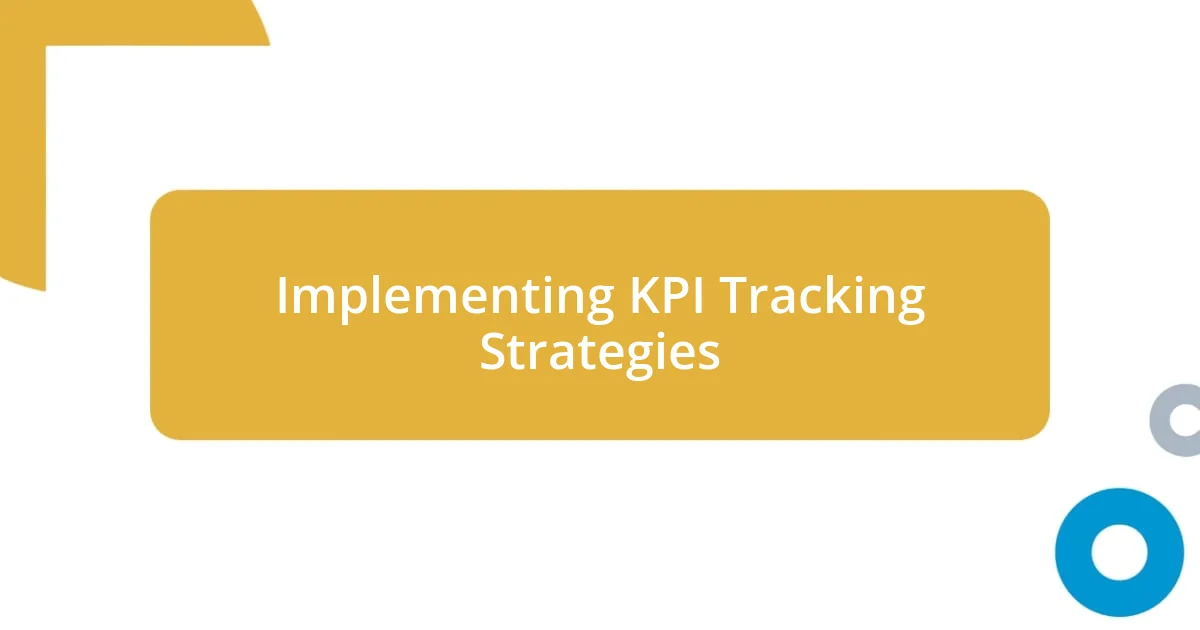
Implementing KPI Tracking Strategies
Implementing KPI tracking strategies requires a thoughtful approach that takes both data and human experience into account. I vividly remember the first time I introduced more visual tracking tools to the team, creating dashboards that made our KPIs not only accessible but engaging. Suddenly, the metrics weren’t just numbers on a report; they became real-time indicators of our shared journey, sparking curiosity and a collective drive to improve. Isn’t it incredible how presenting data differently can reshape perceptions?
Regularly reviewing these tracking methods is also crucial. I implemented a monthly reflection session where we would analyze what worked and what didn’t. This became more than just a routine— it turned into a space for collaboration and ownership. I often found myself thinking, “Are we genuinely using these KPIs to inform our actions, or are we just checking boxes?” This insight prompted us to tweak our strategy to keep the focus on actionable outcomes, ensuring we weren’t just observing but actively responding to our performance.
Moreover, I’ve noticed the profound impact of storytelling in KPI tracking. I started sharing not just the data but the narrative behind it, including personal anecdotes from team members. Each update wasn’t just an analysis; it was a celebration of milestones, big or small. This storytelling approach transformed the way my team engaged with our KPIs. It made the data relatable, helping everyone to see that these indicators aren’t just numbers—they reflect our growth and aspirations.
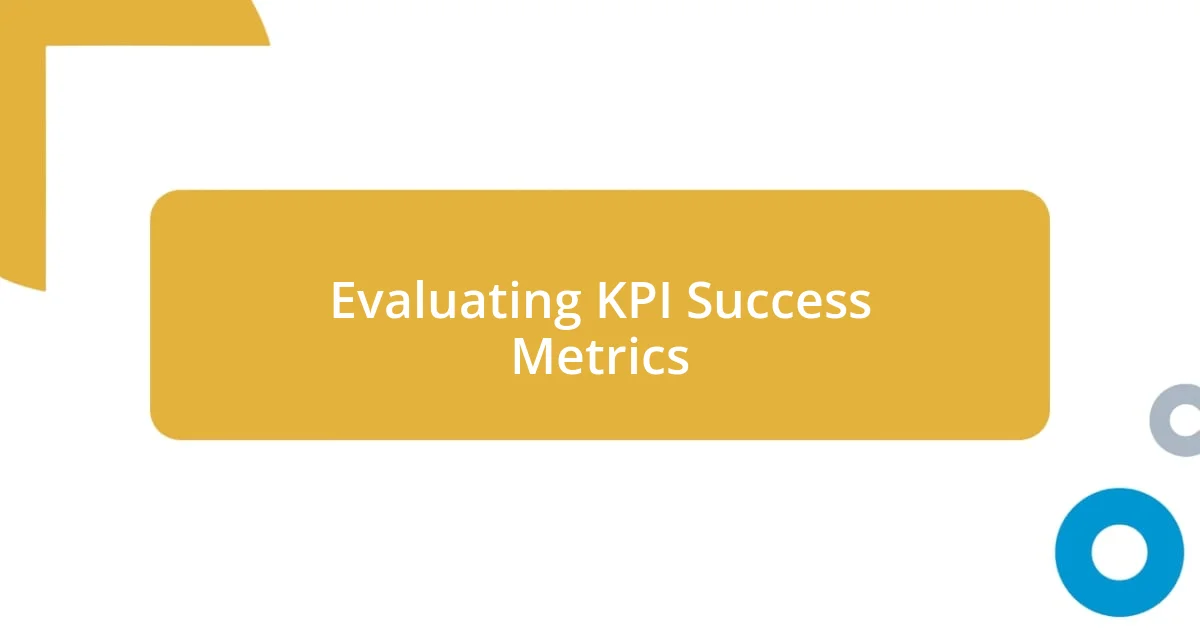
Evaluating KPI Success Metrics
Evaluating KPI success metrics is an ongoing journey that demands a keen eye and a willingness to adapt. I vividly remember one meeting where we scrutinized a particularly disappointing metric—our customer satisfaction score. It was disheartening, but instead of shying away, we asked, “What story is this data telling us?” This question opened the floodgates to discussions that surfaced underlying issues we’d overlooked. Together, we identified specific touchpoints in our customer journey that needed improvement, which led to actionable steps.
As I delved deeper into our KPIs, I realized that qualitative feedback often provided richer insights than cold numbers alone. I began to reach out to our clients directly, asking about their experiences in a more conversational manner. For instance, instead of just analyzing complaint volumes, I made it a point to call five clients each month to hear their stories firsthand. The emotional depth of their feedback not only informed our metrics but also changed the way we fostered relationships. Isn’t it fascinating how personal touch can turn data interpretation into genuine human connection?
Throughout this process, I learned the importance of context in evaluating KPIs. Numbers alone often fail to capture the nuances of our performance. By linking our metrics to broader company goals and employee feedback, I could better assess whether we were genuinely making progress. For example, if our sales figures were high but employee burnout was apparent, I knew we had a larger issue at play. It’s crucial to remember that KPIs don’t exist in a vacuum; they should reflect the overall health of your organization and guide you toward a balanced approach to success.
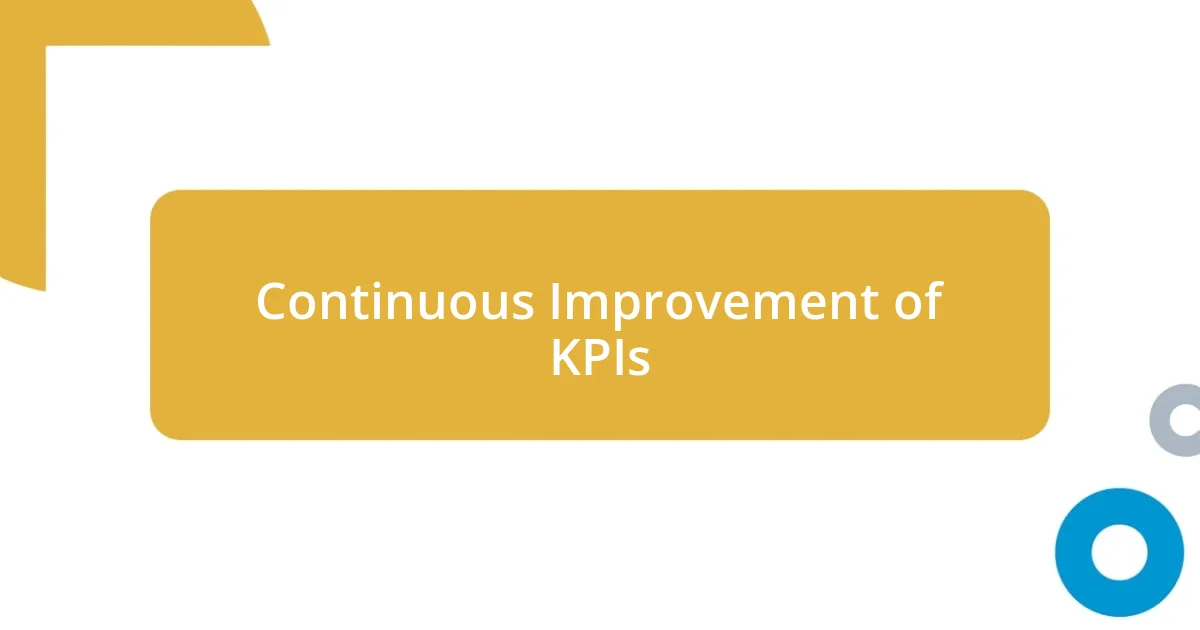
Continuous Improvement of KPIs
Continuous improvement of KPIs is essential for not just measuring success but also fostering a culture of growth. I once introduced a feedback loop where team members could share their thoughts on the KPIs we tracked. The simple act of asking for input made everyone feel more invested. I often wonder, how can you improve something if the people living it daily aren’t part of the conversation?
In one instance, after gathering feedback, we identified that a particular KPI felt disconnected from everyone’s reality. This prompted me to modify it, focusing less on abstract percentages and more on tangible outcomes. I can still recall the moment when my team realized that we could tweak our KPIs to reflect their day-to-day work better. It was a pivotal experience, showing me that KPIs should evolve as our goals and environments change.
Moreover, I firmly believe in setting aside time for innovation around KPIs. I remind my team that every quarter, we should brainstorm ideas for new metrics or refine existing ones. When we engaged in this practice, I could feel the excitement grow. It’s in these sessions where we explored what really mattered—not just for the business but for us personally, and asked ourselves, “What do we truly want to achieve together?” That’s when I discovered that continuous improvement isn’t just about adjusting numbers; it’s about creating shared ownership and commitment to our vision.














